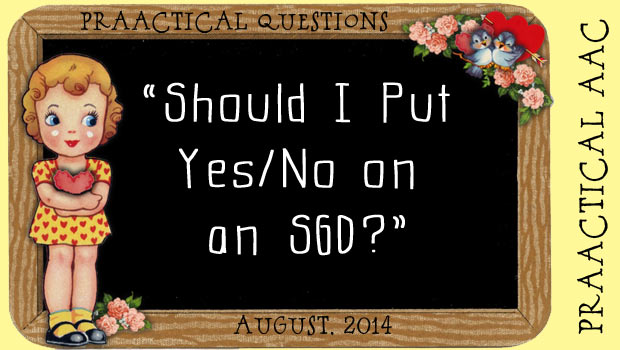PrAACtical Questions: “Should I Put Yes/No on an SGD?”

We got this question from an SLP who recently helped a young adult get funding for a speech generating device (SGD): Should we put symbols for yes and no on the student’s communication device? Like other things in clinical practice, it depends of the specifics of the situation. In this case, she wanted to start out with a very small vocabulary set and build gradually. That sure makes sense, but where she got stuck was with which specific words to include. Team members were encouraging her to include yes and no, hence the question. There is no one-size-fits-all answer for this. Here are some things we think about in making that decision for and with an AAC learner.
- Does he/she have another way to say yes/no? If so, then this may not be the best use of the limited ‘real estate’ on the learner’s SGD. In the case of this SLP, the AAC learner was a teenager and had already established a means of saying yes/no with gestures and vocalizations. This is often true of older learners who have, along with their teams, developed functional strategies for basic expression that they have been using over the years.
- Is the person’s current means of expressing yes/no consistently recognized by others? Sometimes the AAC learner’s yes/no signals are ambiguous or easy to miss. We only have to think back to Ruth Sienkiewicz-Mercer to remind ourselves of the devastating affect this can have on someone’s life. Bottom line: If people aren’t consistently recognizing and responding to the learner’s yes/no signals, consider adding it to the AAC system.
- Is it vocabulary that you are ready to model and/or target? Some of our learners have a focus in other areas. Yes/no answers are used for many different purposes. Developmentally, those communicative intents come in at different points in time. It isn’t a priority for everyone.
- What does the AAC learner want? Not all of the people we work with can give us input on this, but many can. It is good to get into the habit of asking. We’ve written before about some ways to do that.
Yes and no are deceiving. They look like short, simple words, but learning to use them effectively is a complex process. For more information, be sure to read the terrific series that Kate Ahern did on this a few years back. Sometimes it makes good sense to put these words on an AAC device, but, as always, it’s an individual decision based on the merits of the situation.
Filed under: PrAACtical Thinking
Tagged With: PrAACtical Questions, yes no
This post was written by Carole Zangari
